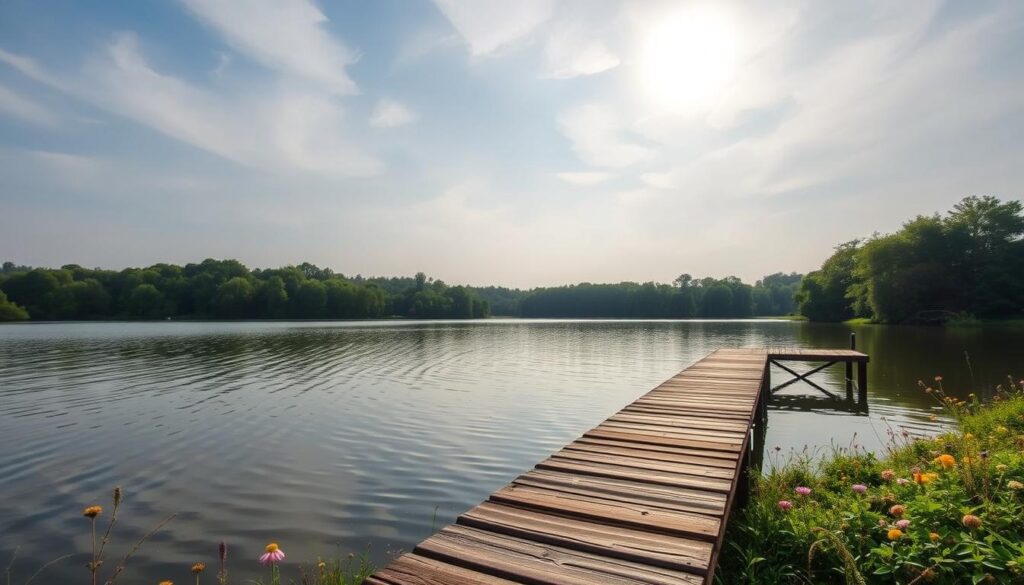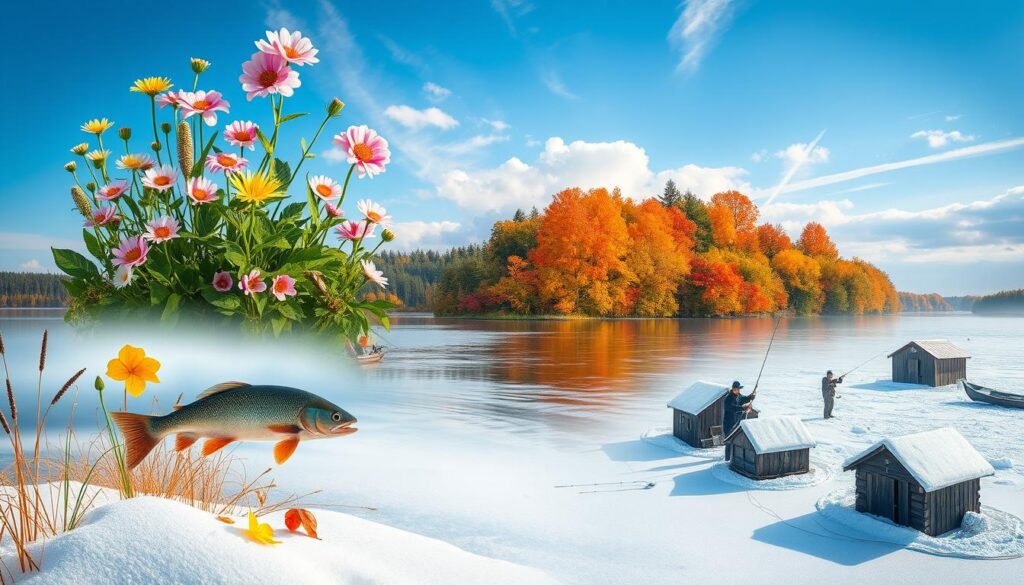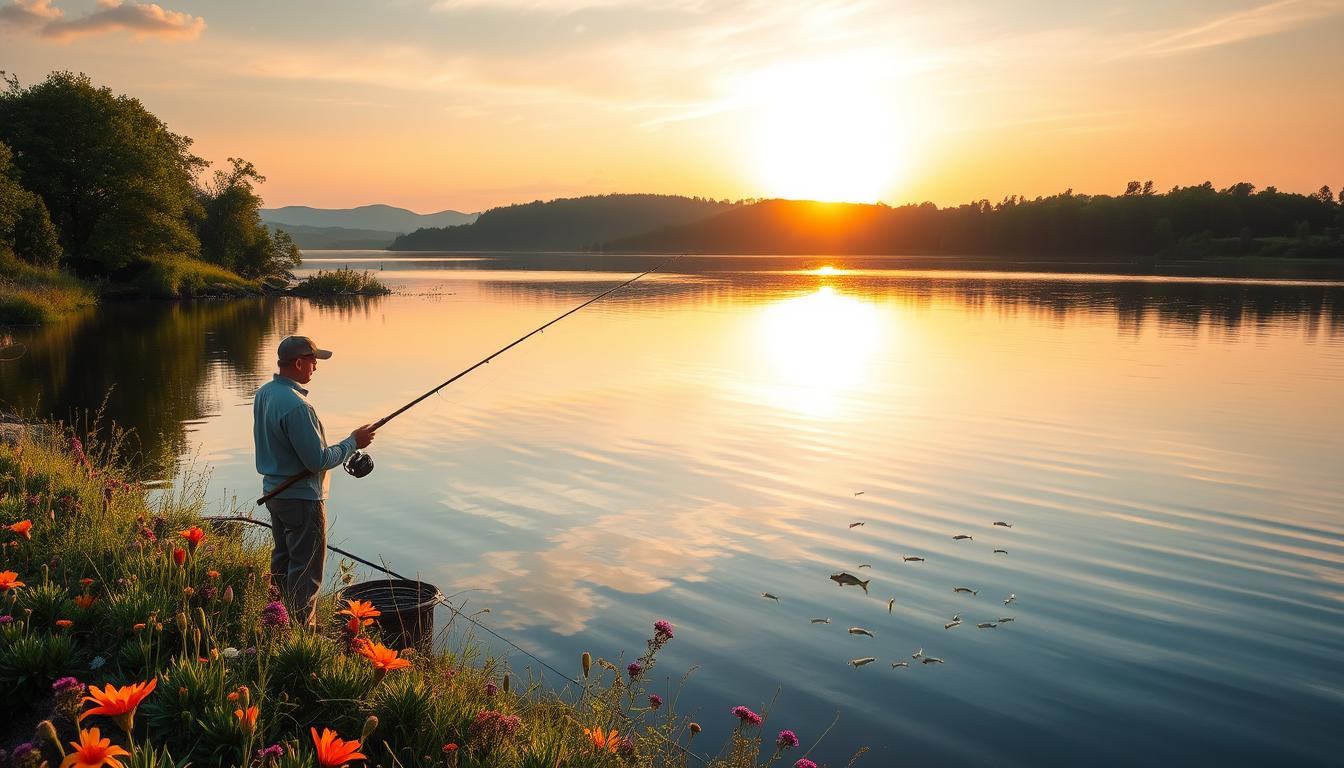Freshwater fishing is a favorite outdoor activity in the United States, with about 40 million people taking part. It’s exciting to fish in calm lakes, fast rivers, or stocked ponds. This guide will give you the basics and gear tips to start your freshwater fishing journey.
There are many fish species to catch, like the strong largemouth bass, the sneaky walleye, and the popular crappie. With the right skills, you can catch these fish and enjoy their unique challenges and rewards.
This guide will help you pick the right gear, learn fishing techniques, find the best spots, and understand the seasons. Knowing how to fish in freshwater will prepare you for your fishing adventures and make your time on the water great.
Table of Contents
Essential Freshwater Fishing Gear and Equipment
Ready to start your freshwater fishing journey? It’s important to have the right gear for a great time on the water. As a beginner, you’ll want simple yet reliable equipment to learn the basics.
Rods and Reels Selection
Choosing the right rod and reel is key. A 6’6″ spin-cast rod with a 150-size spin-cast reel is a good start. Or, try a 6’6″ spinning rod with a 2000-size spinning reel. These sizes are easy to use and versatile for beginners.
For more advanced fishing, consider a 7′ baitcasting rod with a 150-size casting reel. It offers better casting distance and precision.
Fishing Line Types
Monofilament or nylon line in the 10-pound test range is a solid choice. It’s strong, flexible, and affordable. Perfect for beginners.
Basic Tackle and Accessories
Don’t forget to add essential tackle and accessories to your kit. Live baits like worms and minnows are great. Artificial lures such as topwater baits and vibrating jigs offer versatility.
Remember to pack small scissors, pliers, or forceps for easy hook removal. A tackle backpack or box helps keep your gear organized and easy to find.
| Gear Type | Recommended Options |
|---|---|
| Rods and Reels |
|
| Fishing Line |
|
| Tackle and Accessories |
|
Investing in quality fishing gear, fishing rods, fishing reels, and fishing lines will set you up for success. Research and preparation are key to choosing the right equipment for your fishing adventures.
Understanding Different Freshwater Fishing Techniques
As you start fishing in freshwater, knowing the different techniques is key. Each method is best for certain fish and places, helping you catch more. Let’s look at some common techniques for freshwater fishing.
Casting with Spinning Rods
Casting with a spinning rod is easy and great for beginners. Spinning reels are simple to use, making them popular for new anglers. This method lets you fish in many places and catch different fish, like bass and trout.
Baitcasting for Accuracy and Distance
Baitcasting reels are for those who want to cast far and accurately. This technique takes practice but is very effective for fishing in lakes and rivers.
Fly Fishing for Trout and Other Gamefish
Fly fishing is special for catching trout but works for other fish too. It uses a light fly rod and reel to cast artificial flies. This lets you fish delicately and control the lure well.
Trolling for Larger Species
Trolling means moving slowly while fishing with lures behind the boat. It’s good for catching big fish like pike or musky in lakes. Make sure your lures look natural by adjusting your speed.
Choosing the right technique is important for catching fish. Learn about each method and how they work in different places. Try different techniques and be patient as you get better.
| Fishing Technique | Ideal for | Key Considerations |
|---|---|---|
| Casting with Spinning Rods | Bass, trout, and a variety of freshwater species | Beginner-friendly, covers wide areas, versatile |
| Baitcasting for Accuracy and Distance | Targeting specific structures and fishing spots | Requires more skill, but offers precision and long-range capabilities |
| Fly Fishing | Trout and other gamefish | Specialized technique, delicate presentations, precise control over the lure |
| Trolling | Larger fish like pike and musky in lakes and reservoirs | Slow boat speeds, ensure lures swim naturally |
“Fishing is not just a sport, it’s a way of life. Each technique has its own unique charm and rewards, so be open to exploring them all.”
Best Baits and Lures for Beginners
Starting out in freshwater fishing means picking the right baits and lures is key. Knowing when to use live bait or artificial lures can boost your catch rate. It’s all about understanding the best options for each situation.
Live Bait Options
Worms and minnows are top picks for beginners. Worms, especially nightcrawlers, draw in bass, crappie, and bluegill. Minnows, with their natural look, are great for catching northern pike and walleye.
Artificial Lure Selection
Beginners should try soft 5-inch stickbaits, 3/8-ounce spinnerbaits, and shallow-running crankbaits. Hollow-body frogs are also good. These lures are simple yet effective, making them perfect for beginners.
When to Use Each Type
Choosing the right bait or lure depends on the conditions and fish behavior. In clear water, use light, natural-colored lures. In murky water, go for brighter ones. The season also plays a role, as fish preferences change throughout the year.
| Species | Preferred Baits and Lures | Optimal Seasons |
|---|---|---|
| Largemouth Bass | Crankbaits, Spinnerbaits, Soft Plastic Worms, Frogs, Swimbaits | March to November |
| Smallmouth Bass | Senko, Soft Plastic Crawfish, Spinnerbaits | March to June |
| Bluegill | Rooster Tail, Soft Plastic Grubs | March to November |
| Black Crappie | Blade Baits, Jerkbaits | October to April, February to March |
Knowing the best lures and baits for your target species can make your fishing trips better. It’s all about timing and understanding fish behavior. This way, you’ll have a more successful and fun fishing experience.
Choosing the Right Fishing Locations
Finding the right fishing spots is crucial for a great fishing trip. Start by checking your state’s Department of Natural Resources for fishing reports. These reports can guide you to the best fishing spots and the fish you might catch.
Local tackle shops are also a great resource. The staff there can give you tips based on their experience. They know the local waters well.
Pond Fishing
For pond fishing, start with bluegill, crappie, sunfish, catfish, or largemouth bass. These are fish-like areas with trees, logs, or docks. Casting near these spots can help you catch more fish.
Lake Fishing
For lake fishing, a boat is helpful for reaching deeper waters. Look for depth changes and underwater structures with a depth finder. Fish often gather in these areas. Also, consider the water temperature and seasons, as they affect fish behavior.
By using local resources and understanding fish habitats, you can find the best fishing spots. This will make your fishing trips more rewarding and successful.

“The best fishing spots are often hidden in plain sight, and it takes a keen eye and a bit of persistence to discover them.”
Freshwater Fishing Species Guide
Start an exciting journey into the world of freshwater fishing. You can catch bass, trout, or rainbow trout. This guide will help you become a great freshwater angler.
Common Game Fish
The freshwater world is full of exciting game fish. Some top ones are:
- Largemouth and Smallmouth Bass
- Trout, like Rainbow, Brown, and Brook Trout
- Walleye
- Crappie
Each fish offers unique challenges and rewards. From bass‘s fast strikes to trout‘s beautiful jumps. Knowing their habits is key to catching them.
Fish Behavior Patterns
Learning fish habits is vital for better fishing. In winter, fish hide in warmer, deeper spots. But in fall, they’re more active as they get ready for cold weather.
Changing your fishing ways with the seasons can really help. For example, rainbow trout love cold water, up to 70 degrees Fahrenheit.
Seasonal Fishing Strategies
Good anglers change their ways with the seasons. In winter, use slow, deep fishing. In warmer months, go for faster, more active fishing.
By knowing these patterns, you’ll catch more fish. Whether it’s bass, trout, or other species, you’ll get better at freshwater fishing.
Weather and Seasonal Impact on Fishing Success
Fishing success depends a lot on the weather and the season. Knowing how seasons and weather patterns affect fish can help anglers catch more. This knowledge is key to improving fishing success.
In the fall, many anglers find it the best time to fish. It’s great for catching striped bass, bluefish, and trout. Lakes and rivers are also good places to fish during this season.
Before and after storms, fishing is excellent. This is because storms change the barometric pressure. Low pressure before a storm gets fish active, while high pressure makes them less active.
In the winter, fish seek shelter in cold water. Places like bridges and rocky ledges are good spots. Clear waters help in catching fish during this season.
During the spring, fish move closer to shore. This is the best time for catching bass and trout. It’s when they start their spawning season.
In the summer, fish go deeper in cooler waters. Early mornings and late evenings are the best times to fish. Species like bass and pike are very active during these times.
| Season | Fishing Conditions | Target Species |
|---|---|---|
| Fall | Optimal conditions for catching fish | Striped bass, bluefish, rainbow and brown trout, largemouth and smallmouth bass, salmon |
| Winter | Fish seek shelter near structures, clear waters with good visibility | Various species |
| Spring | Fish move closer to shore and shallow waters, spawning season | Largemouth bass, trout |
| Summer | Fish move to deeper, cooler waters, best times are early mornings and late evenings | Largemouth bass, catfish, pike |
Barometric pressure also affects fish behavior. They are most active when pressure is between 29.70 and 30.40 inches. Stable or slowly changing pressure is best for fishing.
Weather conditions like temperature and wind also matter. Overcast skies and light rain can make fish more active. Extreme weather may need different fishing techniques.

Understanding seasonal and weather-related factors helps anglers improve their fishing. Knowing when and where to fish can greatly increase success. This knowledge can lead to better catches.
Safety Tips and Fishing Regulations
Before you go fishing, make sure you know the fishing laws and regulations. Getting the right licenses and permits is key. It helps you fish legally and protects our water resources. Also, knowing and following safety tips makes your fishing trip fun and safe.
Required Licenses and Permits
You might need a fishing license to fish recreationally. These licenses come in different lengths, from a day to a year. You can buy them from state wildlife agencies or approved stores. Always check the fishing laws in your area, as they can change.
Basic Safety Guidelines
When fishing, safety comes first. Always wear a U.S. Coast Guard-approved life jacket or PFD, even if you can swim. Also, watch the weather and don’t fish in bad weather like thunderstorms or strong winds.
Catch and Release Practices
If you’re catch-and-release fishing, handle the fish carefully. Use the right gear, like barbless hooks, and handle the fish as little as you can. Remove the hook gently with pliers or dehookers and release the fish quickly and softly.
Following fishing laws, safety tips, and catch and release practices makes fishing safe and good for the environment. It helps protect our water and ecosystems.
Essential Skills for Freshwater Fishing
Starting your freshwater fishing adventure? It’s important to learn key skills. Mastering casting, tying knots, and understanding water conditions are crucial. These skills will help you become a better fisherman.
Proper casting is a must in freshwater fishing. Work on your accuracy and distance with both spinning and baitcasting reels. This will help you aim for the best spots to catch fish.
Also, learning basic fishing knots is vital. Knots like the improved clinch knot and the Palomar knot keep your line and tackle secure. This is especially important when fighting strong fish.
Knowing how to read water conditions is also key. Look for spots like drop-offs, underwater structures, and current seams where fish might be. Setting the right drag on your reel is also important. It helps you land fish without losing your line.
FAQ
What is the current popularity of freshwater fishing in the U.S.?
There are 40 million people in the U.S. who enjoy freshwater fishing. Its popularity is growing.
What are some common freshwater fish species that can be caught?
You can catch many species in freshwater. These include largemouth bass, walleye, crappie, and muskies.
What essential gear do beginners need for freshwater fishing?
Beginners need a 6’6″ spincast rod and a 150-size spincast reel. They also need a 6’6″ spinning rod and a 2000 spinning reel. A 7′ baitcasting rod with a 150-size casting reel is also important.
For fishing line, use 10 lb. monofilament or nylon.
What basic tackle and accessories should beginners have?
Beginners should have worms, minnows, and various lures. This includes topwater, jerkbait, crankbait, bottom bait, and vibrating jig.
They also need small scissors, pliers, or forceps for hook removal. A tackle backpack is useful for storage and transportation.
What are some common freshwater fishing techniques?
Common techniques include casting with spinning rods. Baitcasting reels are used for accuracy and distance. Fly fishing is good for species like trout.
Trolling involves slowly moving while towing lures. This is effective in lakes.
What are some effective live bait and artificial lure options for beginners?
Live bait like worms and minnows works well. For artificial lures, beginners should try soft 5″ stickbaits, 3/8oz spinnerbaits, shallow running crankbaits, and hollow body frogs.
Where can beginners start fishing in freshwater environments?
Beginners can start by checking their state’s Department of Natural Resources for fishing reports. They can fish in local lakes and rivers.
For pond fishing, target bluegill, crappie, sunfish, catfish, or largemouth bass. When lake fishing, using a boat helps access deeper waters where species like lake trout and walleye reside.
What are some common freshwater game fish and their characteristics?
Common game fish include bass, trout, walleye, and crappie. Rainbow trout are popular among anglers for their beautiful colors and aggressive behavior.
They thrive in cold water, with 70 degrees being their upper temperature limit.
How do seasons and weather impact freshwater fishing?
Seasons and weather greatly affect fish behavior and fishing success. In winter and early spring, fish bite best during the warmest part of the day.
Summer fishing is most productive in early mornings and evenings when the water is cooler. Rainy and overcast days often result in better fishing as fish are more active in darker conditions.
What are the key safety and regulatory considerations for freshwater fishing?
Before fishing, check state regulations and purchase the required fishing licenses. Always wear life jackets when on boats and be aware of weather conditions.
Practice proper hook safety. When practicing catch and release, use appropriate gear to minimize fish stress. Keep the fish in water as much as possible and handle them gently.
What are the essential skills for successful freshwater fishing?
Essential skills include proper casting techniques and knot tying. Practice casting accuracy and distance with both spinning and baitcasting reels.
Learn to tie basic fishing knots like the improved clinch knot and Palomar knot. Develop the ability to read water by identifying likely fish holding areas such as drop-offs, underwater structures, and current seams.
Understanding how to set drag on your reel is crucial for landing fish without breaking your line.

